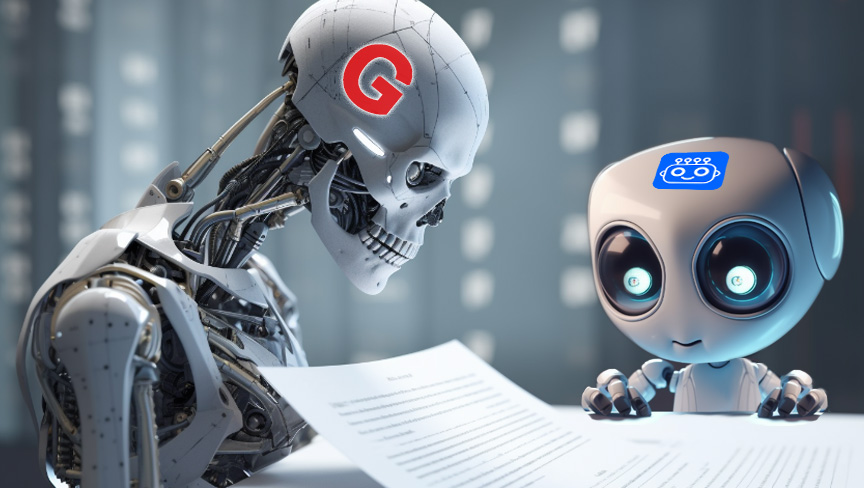“Does Google penalize AI content?” I bet you’ve wondered about that, right? Well, here’s the inside scoop: it’s not quite as cut and dry as it seems.
We’re diving deep into the world where AI and Google collide, teasing apart the myths from reality. So, if you’ve been tinkering with AI to pump out content, you’ll want to stick around.
I promise this is something you won’t want to miss!

Try these new AI-powered tools:
- 5 Best AI Detectors To Unmask AI-Written Content With Accuracy
- 5 Best AI Writers To Boost Your Productivity And Content Quality.
- This "Secret AI Writer" Can Bypass AI Detection Like A Pro.
Well, with the global AI writing tool scene set to explode to a mind-boggling $1.022 billion by 2028, getting the scoop on how and why Google spots AI-generated content is becoming mega-crucial for folks knee-deep in content creation, and especially for those playing the SEO game.
So if you’ve been thinking otherwise, it’s time for a reality check.
Stick around to learn the ropes on how Google reviews sites with AI-crafted material, the tricks of the trade when dealing with AI writing tools, and the potential fallout of dodgy algorithmic content on your site’s search visibility.
Article At-A-Glance
-
- First things first, we need to get a handle on why and how Google sniffs out content that’s been whipped up by AI. With AI writing tools becoming hot property, this can seriously stir up the way we create content and juggle SEO.
- We’ve got to stay on the ball with AI-written content, tweaking it on the fly to keep up with what’s trending and resonate with our users. This lets us serve up content that hits the mark, stays relevant, and is user-friendly.
- Google’s Webmaster Guidelines are all about top-drawer, spot-on, and useful content. So, if you’re just churning out shoddy AI-penned content, you might end up in the doghouse with penalties and your visibility in search results taking a tumble.
- Finding the sweet spot between human input and AI is key to keeping our content from going stale and avoiding the cold shoulder of users or penalties for being a copycat.
Table Of Contents
Does Google Penalize AI Content? Let’s Unpack Their Guidelines On AI Content
Now we’re at the million-dollar question, will Google slap you for using AI content? Sooner or later, something’s gotta give, right?
Here’s the scoop. Right now, Google isn’t handing out yellow cards for AI-generated content. But who’s to say things won’t do a 180 in the future?
Got some handy guidelines tucked up my sleeve, just in case the day comes when Google starts throwing penalty flags at AI content.
Google’s Two Cents on AI Content
Google recently set the record straight that using AI-generated content on your website or blog isn’t crossing any lines in their rulebook, the Webmaster Guidelines.
They’re more interested in top-notch content that’s SEO-friendly and helps users get to the bottom of what they’re looking for.
Here’s the scoop on what they had to say:
“Appropriate use of AI or automation is not against our guidelines. This means that it is not used to generate content primarily to manipulate search rankings, which is against our spam policies.”
Google’s ranking systems have always been built to give props to unique, quality content that’s got the E-E-A-T (Experience of User, Expertise, Authority, and Trustworthiness) factor down pat, as laid out on their “How Search Works” page.
They’ve been clear as day that their focus is on the quality of the content, not how it’s cooked up, which has let them keep dishing out reliable, first-rate results for users over the years.
About ten years back, there was a flood of mass-produced, human-spun content that raised a few eyebrows. But rather than giving all human-crafted content the cold shoulder, Google decided to up its game and reward top-drawer content.
Right from the word go, Google’s made it a mission to spot and promote quality content.
Right from the word go, Google’s made it a mission to spot and promote quality content. This legacy lives on today through its ranking systems that aim to put reliable info on a pedestal and its beneficial content ecosystem.
And they didn’t stop there. They went on to say:
“It’s important to recognize that not all use of automation, including AI generation, is spam. Automation has long been used to generate helpful content, such as sports scores, weather forecasts, and transcripts. AI has the ability to power new levels of expression and creativity, and to serve as a critical tool to help people create great content for the web.”
You can snoop into Google’s own words on AI content generation right over here. They’ve laid it all out on the line for you.
Now here’s the kicker. While AI-powered websites can churn out written assets at breakneck speed thanks to Machine Learning algorithms and NLP tools, there’s a risk of producing bottom-of-the-barrel content.
For a piece – be it an article or blog post – created with the help of AI tools to make the grade with Google, it should get a once-over from a human editor first. This ensures it’s unique and the grammar’s on point throughout the text.
In other words, it needs a human’s magic touch.
Google’s No-Nos With AI-Crafted Content
- Automatically generated content (stuff solely whipped up by machines without any human intervention) is a big no-no according to Google’s current guidelines.
- Content that’s been rehashed from existing material and doesn’t bring anything new to the table could also earn a penalty.
- Content that’s just a front for SEO games like keyword stuffing, cloaking, or link spam could also get flagged by Google’s algorithm.
- Low-quality content knocked out using AI writing tools could also fall foul of Google if it’s impersonal, doesn’t offer fresh insights, or doesn’t bring anything valuable to the table for web searchers.
Beware: It’s Search-Engine Jail Time For Low-Quality Content
So, while AI-crafted content can be a marketer’s secret weapon, it could also end up churning out low-grade content. And you could pay a pretty penny for that.
Yep, Google comes down hard on low-quality AI content.
Subpar websites with gobbledygook text could see a drop in search visibility or even get booted off the index completely.
Subpar websites with gobbledygook text could see a drop in search visibility or even get booted off the index completely.
And when that happens, your website’s going to be like a ghost town.
To dodge penalties dished out because of AI-crafted content, we need to keep an eye not just on the readability of our work but also on how original it is.
Making use of editing tools given the thumbs up by industry pros can help spruce up content.
AI And The Art Of Crafting Content
AI has come in like a wrecking ball in content creation, shaking things up in a big way. AI tech can chew through a mountain of data and learn from existing content to copy human-like writing styles and preferences.
What does this mean for us? Businesses and people alike can now crank out top-tier content more efficiently, and in no time flat.
With AI backing you up, the creative process becomes a walk in the park, giving you more time to tackle other important stuff. It’s like having a cutting-edge buddy who brings a dash of wizardry to content creation.
What’s AI-Generated Content, You Ask?
AI-generated content is essentially digital content cooked up mostly or entirely by artificial intelligence. You might also hear it called AI-written, machine-generated, or computer-aided writing.
This type of content comes to life through natural language processing (NLP) and detection algorithms, which crunch all sorts of data points – think grammar, syntax, and relationships between words and phrases – from ginormous datasets to spit out digital text.
Over the years, AI has become a bit of a secret weapon for writers. It’s a lifesaver when it comes to knocking out high-quality work in less time and with less sweat than traditional human writing methods.
The Good, the Bad, and the Ugly of AI in Content Creation
AI-generated content brings a heap of goodies to the table. For one, it’s a major time-saver in the content creation and development process, as we’ve already mentioned.
Since AI can digest mountains of data, AI-written content can whip up more personalized and engaging content that’s right up a specific audience’s alley, giving customer engagement and satisfaction a major leg-up.
That’s another big tick for AI content creation.
For starters, AI-written content can be a bit of a creative buzzkill, so it doesn’t always hit the engagement heights that human writing can.
But let’s not forget these automated services have their fair share of quirks and risks. For starters, AI-written content can be a bit of a creative buzzkill, so it doesn’t always hit the engagement heights that human writing can.
Also, shoddy content knocked out by AI writing tools might not deliver your message quite the way you meant.
It could end up leaving people browsing your site a bit lost, not giving them the useful info they’re after. That’s why it’s crucial to find the right balance between using these services and letting humans have a hand in the content creation process.
How Google Sniffs Out AI Content Like A Bloodhound
To figure out if content is a work of AI, Google’s got some pretty nifty algorithms that can pick up on language patterns and stack them up against the rest of the web content out there.
Here’s a rundown on how Google’s got AI content’s number.
Well-Primed Machine Learning Algorithms
AI tech, like machine learning algorithms, are now super handy tools in the search engine toolbox. They help search engines make the call on how relevant and high-quality the bazillions of online content are.
Machine learning, a kind of AI, uses data and algorithms to help computers learn on the job with new data they come across.
This way, the computer can spot patterns and weird language stuff, which helps tell apart top-tier AI content that plays by Google’s rules and the shoddy AI content that doesn’t, without needing any humans to step in.
Publishers who use AI writing tools on the up and up, following the best practices, can soup up their webpages to meet SEO standards.
Deep-Learning Language Pattern Analysis
Google’s out there using language pattern analysis to sniff out AI-generated content. It’s on the lookout for phrase patterns that stick out like a sore thumb and a heavy repeat of certain keywords, dead giveaways of text cooked up by AI.
This is all about deep learning, a kind of machine learning technique that uses neural networks stacked up like a club sandwich to untangle the complicated patterns and relationships in data.
This gives AI systems the chops to understand language structures that used to leave them scratching their heads.
Fine-Tuned Writing Style Analysis
Google might even dive into other factors like writing styles to put a finger on AI-generated content.
Google’s algorithms are all set to pick apart the unique and distinct vibe of a piece of written content.
Google might whip out some fancy tricks to spot patterns and weird stuff in the writing style that might point to AI’s fingerprints.
This covers everything from the author’s choice of words, how the sentences are put together, the tone, voice, and the whole shebang. The way a piece is written is key to getting the message across, vibing with the target audience, and setting a certain mood or feeling.
So, Google might whip out some fancy tricks to spot patterns and weird stuff in the writing style that might point to AI’s fingerprints.
Best Practices for AI Content and SEO
It’s super important to understand and put into practice the best moves for AI content and SEO, and for a bunch of reasons. First off, AI-generated content needs some careful guidance to make sure it’s in line with the rulebook, laws, and what people expect in terms of quality.
By sticking to the best practices, content creators can make sure that AI-generated content stays trustworthy, relevant, and a solid help for users.
Also, mixing in SEO best practices helps content stand out to search engines, upping its visibility and organic ranking.
Getting AI-generated content shipshape for SEO helps draw in the crowd you’re targeting, amp up user experience, and boosts the chances of reaching out to more peeps.
Plus, keeping up with the latest in AI and SEO best practices means that content creators can roll with the changes when algorithms and industry trends shift, putting them in a good place for success in the long haul in the online world.
Here are the top tips for AI content and SEO.
Balancing AI And Human Touch In Content Creation
AI-generated content can be a big help in SEO without throwing quality or originality under the bus. Automation tools can help you whip up ideas in a jiffy, tweak texts for SEO, and make sure everything’s in sync across different pieces of content.
But it’s important to keep a human touch in the mix, because AI can’t nail the kind of subtlety that comes with a natural writing style that knows the target audience like the back of your hand.
When you’re juggling AI-generated content with human input, you gotta keep a close eye on how your SEO’s doing and switch up keywords on the fly (like rewording paragraphs based on changes in the search engine results pages).
Having a top-notch writer or editor spruce up AI-generated content can help churn out quality stuff.
Making Sure Content Is One-Of-A-Kind And Original
The big worry with AI-spun content is that it might be lacking in the originality department. While machine-written text can mimic the style and tone of existing articles, it can’t hold a candle to the creativity and originality of the human brain.
Without being unique or meaningfully relevant, AI-written content will end up in the bin marked “low-grade spam content.”
Without being unique or meaningfully relevant, AI-written content will end up in the bin marked “low-grade spam content.”
And this is something Google’s algorithms are trained to spot.
Tools like plagiarism checkers can help catch any copied bits in both human and machine-written text so authors can fix any hiccups made by automated writing software.
Keeping An Eye On AI-Generated Content
You gotta keep tabs on your AI-generated content to make sure it’s hitting all the right marks in terms of quality, relevance, and keeping your users happy.
You wanna catch any bumps in the road before they become mountains, fix any mistakes, and make sure your AI content is singing the same tune as your brand, keeping on the right side of the law, and giving out info that’s on the money.
Plus, feedback from users and engagement stats can give you some golden nuggets to tweak your AI-generated content.
AI tech’s always on the move, so you gotta stay in the loop. By making the right moves at the right time, you can keep your AI-generated content relevant, engaging, and tuned into your users’ needs. This can keep your content top-tier, build trust with your readers, and keep you ahead of the game in the dog-eat-dog world of digital.
Staying On Top Of Google’s Rules
You’ve probably heard this a million times, but it’s worth saying again: Google’s guidelines are always on the move.
So, if you’re cooking up AI content, you gotta keep your eyes peeled for any changes or updates so you can make the most out of AI without stepping on Google’s toes or sinking in the search rankings.
So, if you’re cooking up AI content, you gotta keep your eyes peeled for any changes or updates so you can make the most out of AI without stepping on Google’s toes or sinking in the search rankings.
For example, keeping to Google’s E-A-T guidelines means your AI-generated content’s based on legit sources and sounds like it was written by a real person.
Knowing what Google’s looking for in a top-notch page helps you spot any potential problems with your existing pages.
Ignore the rules, and you could end up sliding down the rankings or even getting a slap on the wrist from Google. That could flush all your hard work down the drain.
Make The Most Of AI in Content Creation Without Throwing Quality Or SEO Under The Bus
There’s no two ways about it, AI tech’s got the potential to flip the content creation process on its head.
Businesses can use its time-saving and money-saving powers to whip up top-quality SEO content without breaking the bank.
But, using AI in content creation has its own set of speed bumps that you gotta handle with care.
A business can totally get the benefits of using AI-generated content without losing ground on Google’s rankings or risking a telling-off from the search engine algorithms.
The secret sauce is finding the right balance between human input and automation. It’s not just about churning out quality SEO content faster, but also making sure that content’s got enough originality to slip past Google’s checks.
The human touch brings a fresh perspective, gets the subtleties of context, and adds a dash of credibility. All vital ingredients for crafting content that’s engaging, authoritative, and ticks all of Google’s boxes.
Meet our resident tech wizard, Steve the AI Guy. Now, before you get any wild ideas, let’s clear up one thing – he’s 100% human! I mean, he’s got the work history to prove it. He spent a decade diving into the deep end of the tech industry doing business intelligence work, splashing around with two of the world’s largest business consulting companies, Deloitte and Ernst & Young. Learn More










